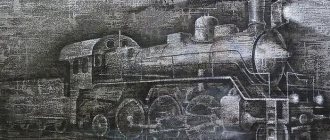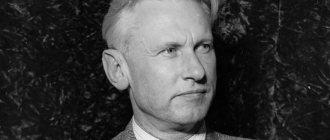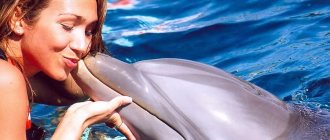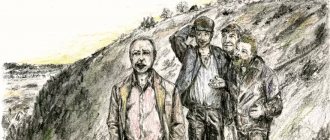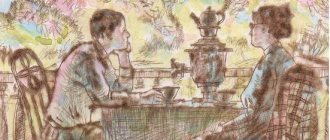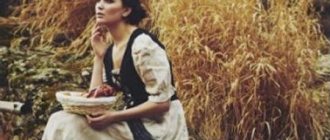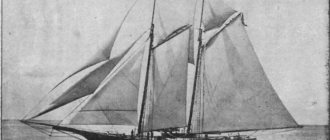Plot - summary
- Yura and Kostya again get bad marks, and the guys scold them at the meeting.
- Barankin casts a special spell to turn into sparrows and live without worries.
- However, having become sparrows, the guys are exposed to various dangers, and they decide to turn into butterflies.
- Kostya is almost caught with a net by girls from his same class, but the boys manage to turn into ants.
- They work hard on the anthill and get into a war with the red ants.
- Kostya almost dies, but at the last moment Barankin manages to turn himself and his friend into people.
Summary of Barankin be a man Medvedev for a reader's diary
Author: Valery Medvedev
Year of writing: 1961
Genre: story
Main characters: Schoolboy Yura Barankin, his friend Kostya Malinin.
Plot:
Fascinating story by Valery Medvedev “Barankin, be a man!” loved by many generations of children for the incredibly interesting adventures of its characters, ease of presentation and answers to some, sometimes not quite childish, questions.
It all starts with the fact that two friends, Yura Barankin and Kostya Malinin, receive bad marks in geometry in the very first week of September. Their classmates are outraged, because they all really wanted to be the best in school in terms of academic performance and hoped that every student would do their best. And two carefree friends did not want to waste time preparing for the lesson and let their comrades down. What was especially offensive for everyone was the fact that these were the very first grades in the class in the beginning of the year. Yura and Kostya, in turn, do not understand the general indignation; they believe that if the mathematician had called someone else, then there would be no problem, and they themselves had nothing to do with it.
The general meeting of the class decided to work with the laggards so that they would not disgrace the entire team, and the excellent student Misha Yakovlev should start this coming Sunday, immediately after planting trees in the garden.
On Sunday morning, while waiting for classmates, friends discuss the past meeting and are indignant at the fact that instead of Sunday rest they should be engaged in social activities and cramming geometry. Yura finds the call from excellent student Zina especially offensive: “Barankin, be human!” It's as if he's not a person at all! But it must be great to be not a person, but a sparrow, for example! You sit on your own branch, tweet all day and no lessons, no public assignments! And this idea captivates the children so much that, having hastily composed a simple spell, they alternately turn into sparrows, butterflies and ants. However, such a life turned out to be completely carefree. It turned out that you need to study, and work, and look for food, and dodge numerous dangers. Sparrows escape from cats and are shot at with a slingshot. Young people hunt butterflies, collecting them in collections; in addition, in the fall they go to bed and it is not known whether they will be able to wake up in the spring. And ants generally work until dark, obeying instincts, and they are attacked by myrmics, waging a very cruel and bloody war. And no one, absolutely no one knows what Sunday rest is!
Proverbs for the work
Hard to learn, easy to fight.
Learning is light and ignorance is darkness.
Die yourself, but help your comrade.
Friend is known in trouble.
You can't get fish out of a pond without difficulty
Back to Contents
Hello! My name is Maria, I am the author of the Pushkin website. I hope that my site helps you, in turn I ask for your help. My son was diagnosed with autism. He needs daily correctional activities, if you can help, I will be grateful to you. Every 10 rubles you give is another chance for my child to live a full life. Collection page here
“Barankin, be a man!” (1961)[edit]
A tale about two ordinary Soviet schoolchildren who, trying to dodge extra classes on Sunday, turned into sparrows, then butterflies, then ants. Having returned to human form, they improved and stopped getting bad marks. The most popular book in the trilogy, it is filmed as a cartoon and is often staged on school stages.
Here the protagonist appears for the first time - schoolboy Yura Barankin with excellent but realistic physical characteristics (he does exercises every morning) and an irrepressible imagination (bordering on autism from the category of “Asperger’s syndrome”), as well as his friend Kostya Malinin, a typical partner.
What's there[edit]
- Animagus - transformations of Barankin and Malinin. The author does not explain how they manage to do this, because it’s a fairy tale. For the youngest readers, the author gives reasons: “If you really want...
” - A fable is the general mood of a work. The book is criticized precisely for its edification; this is not the case in the sequels. On the other hand, for these unobtrusive adventures of goofballs, this particular part was loved so much that for many it overshadowed everything else...
- The sinister cat is Muska for Barankin and Malinin when they were sparrows.
- The catchphrase is “Barankin, be a man!” Put in the title.
- An unfortunate fable - if Barankin and Malinin turned into two cats or two dogs, everything would have worked out for them. But this did not occur to any of them. Even when they were almost eaten by a cat in the form of sparrows, no one thought about the cat form. Apparently, they themselves suffered from the sin of shooting at the animal with a slingshot and were aware that the life of a stray animal was definitely not their dream. It seemed easier to be birds or butterflies. It turned out that it only seemed so.
- Children don’t care, especially since the word “ant” is masculine. But when did the butterflies hibernate at the very beginning of September
, when a week ago it was still summer?
"The Super-Adventures of a Super-Cosmonaut" (1977)[edit]
A fantastic story about a teenage schoolboy with phenomenal physical fitness and phenomenal intelligence, but unable to establish normal relationships with the team. Several years passed, Yura Barankin moved to another school and changed his last name to Ivanov, so as not to be reminded of his transformations (the book can also be understood that this is not the same Yura Barankin, but it is most often published as a continuation of the first). At the same time, his human abilities developed to an inhuman level, but Asperger's syndrome also began to go off scale (in the USSR they did not know this diagnosis, but the symptoms put the pedal to the floor). Barankin Ivanov’s dream is to become an astronaut, and for this he comes up with a system of “over-training”.
What's there[edit]
- Composes the words - chedozempr, psip, sverks (Man Worthy of Earth's Gravity (accordingly, chenezempr - unworthy), Complete Collection of Nature's Inventions, Super-Cosmonaut). And others.
- People-plus - this is exactly the state the main character intends to move into during the implementation of the above projects.
- Release with laughter - the excessive seriousness of the story is repeatedly relieved by moments when you can laugh heartily at the protagonist. For example, a fight, during which he gives aloud a scientific lecture about what a blow is.
- Reverse interrogation - when Yura Barankin Ivanov was detained by police officers, one of them was forced to call for help, shouting “The detainee is interrogating me!”
- What happened to the mouse? - Where did Kostya Malinin go? Except that this is not the same Yura Barankin, and I don’t really believe that.
.
- Non-standard happy ending - Yuri BarankinIvanov abandoned his super-program of super-training for the sake of simple Chenezempr happiness.
So the first chedozempr, psip and sverks in history became an ordinary human schoolboy, finally took the place of a cog in the system of society and found a potential lady of his heart. Consider this a success in getting rid of eighth-grader syndrome, if not Asperger's syndrome, and social adaptation, the tragedy of a genius's inevitable understanding and acceptance of his limitations in the emotional sphere, or the tragedy of a genius who broke down on the way to his dream of becoming an astronaut and caved in to society (no one denies the hero's abilities), remains at the discretion of the reader .
However, Tanya clearly approves of Yura’s dream of becoming an astronaut, writes poems about his flight and in the finale invites him to continue training.
And in the third book it turns out that he has a Great Space Odyssey ahead of him .
But you can succeed with him in life as an eccentric genius .
Who are the main characters in the book “Barankin, Be Human!” and their characteristics?
The book “Barankin, be a man!”
includes stories about the adventures of two friends, who are the main characters of the work. 2) Kostya Malinin, another poor student and a lazy person, and also a coward. He agrees with his friend Yura in everything and obeys him.
3) Zinka Fokina, the girl is the head of the class in which two friends study.
4) Mishka Yakovlev, a boy who studies well, a classmate of Yura and Kostya, he was supposed to study with the guys.
The main characters of the fairy tale “Barankin, be a man!”:
Yura Barankin. He is not a good student, often gets bad grades and lets down the whole class. Likes to misbehave. Lazy person. But the boy is resourceful and creative, endowed with imagination.
The story teaches the right attitude towards learning. Both losers eventually understand that they need to try. They want to start studying hard.
But the kids really didn’t want to do their homework on Sunday, but rather turn into carefree birds. Only it turned out that life is no easier for birds either: you have to be careful not to be caught by cats or so that some guy like Venka doesn’t shoot with a slingshot.
Transformation into butterflies or ants also did not bode well; they also have their own problems, worries, and dangers.
From Valery Medvedev’s fairy tale “Barankin, be a man!” we learn about the adventures and misadventures of two friends Kostya Malinin and Yura Barankin. Schoolchildren can be called ordinary boys, mischievous and restless, but they really don’t like to study.
There are many characters in the work, including almost all of Kostya and Yura’s classmates, but the main characters, from my point of view, are Malinin and Barankin.
Yura is more active, constantly coming up with something, very active and energetic.
Kostya is calmer and more reasonable.
To become free from all human worries, especially from studying, friends become sparrows, then butterflies, then ants.
Here are the main characters of the work “Barankin, be a man!”
In this fantastic story, we learn how two guys who don’t really want to study decide that other animals or insects have a much better and more interesting life than people.
Children turn into sparrows, then butterflies, then ants, but it turns out that not everything is so simple. In each of their new guises they face danger and even a threat to their lives.
The main characters in this work are:
Kostya Malinin, Yura's friend. He is calm and quiet, but absent-minded.
Source
